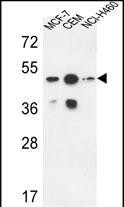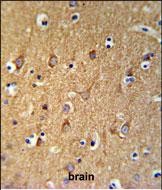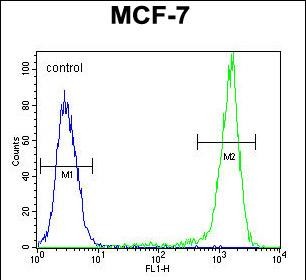SGMS2 Antibody (C-term)
Affinity Purified Rabbit Polyclonal Antibody (Pab)
- 产品详情
- 文献引用 : 1
- 实验流程
- 背景知识
Application
| WB, IHC-P, FC, E |
|---|---|
| Primary Accession | Q8NHU3 |
| Other Accession | Q4JM44, Q9D4B1, Q4R763 |
| Reactivity | Human |
| Predicted | Monkey, Mouse, Rat |
| Host | Rabbit |
| Clonality | Polyclonal |
| Isotype | Rabbit IgG |
| Calculated MW | 42280 Da |
| Antigen Region | 338-365 aa |
| Gene ID | 166929 |
|---|---|
| Other Names | Phosphatidylcholine:ceramide cholinephosphotransferase 2, Sphingomyelin synthase 2, SGMS2, SMS2 |
| Target/Specificity | This SGMS2 antibody is generated from rabbits immunized with a KLH conjugated synthetic peptide between 338-365 amino acids from the C-terminal region of human SGMS2. |
| Dilution | WB~~1:1000 IHC-P~~1:100~500 FC~~1:10~50 E~~Use at an assay dependent concentration. |
| Format | Purified polyclonal antibody supplied in PBS with 0.09% (W/V) sodium azide. This antibody is purified through a protein A column, followed by peptide affinity purification. |
| Storage | Maintain refrigerated at 2-8°C for up to 2 weeks. For long term storage store at -20°C in small aliquots to prevent freeze-thaw cycles. |
| Precautions | SGMS2 Antibody (C-term) is for research use only and not for use in diagnostic or therapeutic procedures. |
| Name | SGMS2 {ECO:0000303|PubMed:30779713, ECO:0000312|HGNC:HGNC:28395} |
|---|---|
| Function | Sphingomyelin synthase that primarily contributes to sphingomyelin synthesis and homeostasis at the plasma membrane. Catalyzes the reversible transfer of phosphocholine moiety in sphingomyelin biosynthesis: in the forward reaction transfers phosphocholine head group of phosphatidylcholine (PC) on to ceramide (CER) to form ceramide phosphocholine (sphingomyelin, SM) and diacylglycerol (DAG) as by-product, and in the reverse reaction transfers phosphocholine from SM to DAG to form PC and CER (PubMed:14685263, PubMed:17449912, PubMed:17982138, PubMed:18370930, PubMed:38388831). The direction of the reaction appears to depend on the levels of CER and DAG in the plasma membrane (PubMed:14685263, PubMed:17449912, PubMed:17982138, PubMed:18370930). Does not use free phosphorylcholine or CDP-choline as donors (PubMed:14685263). Can also transfer phosphoethanolamine head group of phosphatidylethanolamine (PE) on to ceramide (CER) to form ceramide phosphoethanolamine (CPE) (PubMed:19454763). Regulates receptor-mediated signal transduction via mitogenic DAG and proapoptotic CER, as well as via SM, a structural component of membrane rafts that serve as platforms for signal transduction and protein sorting (PubMed:17449912, PubMed:17982138). To a lesser extent, plays a role in secretory transport via regulation of DAG pool at the Golgi apparatus and its downstream effects on PRKD1 (PubMed:18370930, PubMed:21980337). Required for normal bone matrix mineralization (PubMed:30779713). |
| Cellular Location | Cell membrane; Multi-pass membrane protein. Golgi apparatus membrane; Multi-pass membrane protein. Note=Primarily localized at the plasma membrane with a small fraction at the Golgi apparatus. |
| Tissue Location | Brain, heart, kidney, liver, muscle and stomach. Also expressed in a number of cell lines such as carcinoma HeLa cells, hepatoma Hep-G2 cells, and colon carcinoma Caco-2 cells |
For Research Use Only. Not For Use In Diagnostic Procedures.

Provided below are standard protocols that you may find useful for product applications.
BACKGROUND
Sphingomyelin, a major component of cell and Golgi membranes, is made by the transfer of phosphocholine from phosphatidylcholine onto ceramide, with diacylglycerol as a side product. The protein encoded by this gene is an enzyme that catalyzes this reaction primarily at the cell membrane. The synthesis is reversible, and this enzyme can catalyze the reaction in either direction. The encoded protein is required for cell growth. Three transcript variants encoding the same protein have been found for this gene.
REFERENCES
Ternes, P., et al. J. Lipid Res. 50(11):2270-2277(2009) Liu, J., et al. Arterioscler. Thromb. Vasc. Biol. 29(6):850-856(2009) Tani, M., et al. Biochem. Biophys. Res. Commun. 381(3):328-332(2009) Wang, W., et al. Plant Cell 20(11):3163-3179(2008) Yeang, C., et al. Biochim. Biophys. Acta 1781(10):610-617(2008) Villani, M., et al. Biochem. J. 414(1):31-41(2008)
终于等到您。ABCEPTA(百远生物)抗体产品。
点击下方“我要评价 ”按钮提交您的反馈信息,您的反馈和评价是我们最宝贵的财富之一,
我们将在1-3个工作日内处理您的反馈信息。
如有疑问,联系:0512-88856768 tech-china@abcepta.com.






















 癌症的基本特征包括细胞增殖、血管生成、迁移、凋亡逃避机制和细胞永生等。找到癌症发生过程中这些通路的关键标记物和对应的抗体用于检测至关重要。
癌症的基本特征包括细胞增殖、血管生成、迁移、凋亡逃避机制和细胞永生等。找到癌症发生过程中这些通路的关键标记物和对应的抗体用于检测至关重要。 为您推荐一个泛素化位点预测神器——泛素化分析工具,可以为您的蛋白的泛素化位点作出预测和评分。
为您推荐一个泛素化位点预测神器——泛素化分析工具,可以为您的蛋白的泛素化位点作出预测和评分。 细胞自噬受体图形绘图工具为你的蛋白的细胞受体结合位点作出预测和评分,识别结合到自噬通路中的蛋白是非常重要的,便于让我们理解自噬在正常生理、病理过程中的作用,如发育、细胞分化、神经退化性疾病、压力条件下、感染和癌症。
细胞自噬受体图形绘图工具为你的蛋白的细胞受体结合位点作出预测和评分,识别结合到自噬通路中的蛋白是非常重要的,便于让我们理解自噬在正常生理、病理过程中的作用,如发育、细胞分化、神经退化性疾病、压力条件下、感染和癌症。








